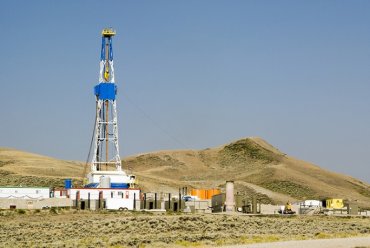An increase in active oil and gas rigs will drive commercial and industrial lubricant demand growth in the United States over the next few years, according to a recent study.
Commercial and industrial lubricant demand in the U.S. is projected to grow at a compound annual rate of approximately 1 percent until 2022 – reaching 497 million gallons, compared to 472 million gallons in 2017 – according to a report published by Cleveland, Ohio-based market research firm The Freedonia Group.

Photo: Jim Parkin/Shutterstock
An oil rig in Wyoming. An increase in oil and gas rigs in the U.S. is expected to drive lubricant demand growth within the next few years, according to a recent study.
Oil and natural gas production is expected to grow faster than any other commercial and industrial market – 4.1 percent annually through 2022, according to the report – leading to the increase in active oil and gas rigs, Freedonia forecasted. In 2017, the base year of the study, the average number of active rigs was 876. In 2018, the average number of active rigs is 1,027, while there are currently 1,079 active rigs, Christine OKeefe, industry analyst at the firm, told Lube Report. This number should continue to recover over the next few years, reaching well over 1,000 by 2022.
This is because of increasing oil and gas prices, she continued. Prices have fallen recently, but there is a lag between changes in oil and gas prices and changes in the number of active oil and gas rigs. Even if oil and gas prices continue to fall, active rig numbers may still grow over the next few months.
Oil and gas rigs have a number of pumps and engines which require lubrication. For example, power generation engines will require engine oils, while drive trains and other power transmission equipment will require transmission and hydraulic fluids, said OKeefe. In 2017, demand for engine oil in the oil and gas industry was 74 million gallons, while demand for transmission and hydraulic fluid was 6 million gallons.
Lubricant demand will also be supported by the rapid adoption of new oil and gas exploration equipment technology and its engine oil standards. Biobased lubricants will also experience a boost because well drilling often happens in environmentally sensitive areas.
Other expanding markets will contribute to the increase in lube demand, but some factors also restrict, according to OKeefe. Growth in the production of heavy trucks and buses and increasing numbers of active oil and gas rigs will support growth in demand for lubricants through 2022. Expanding construction activity will also boost demand, she explained. However, the penetration of more efficient machinery and the associated lengthening drain intervals, will restrain lubricant demand growth. The increasing use of longer-lasting, higher quality lubricants will also negatively impact demand.